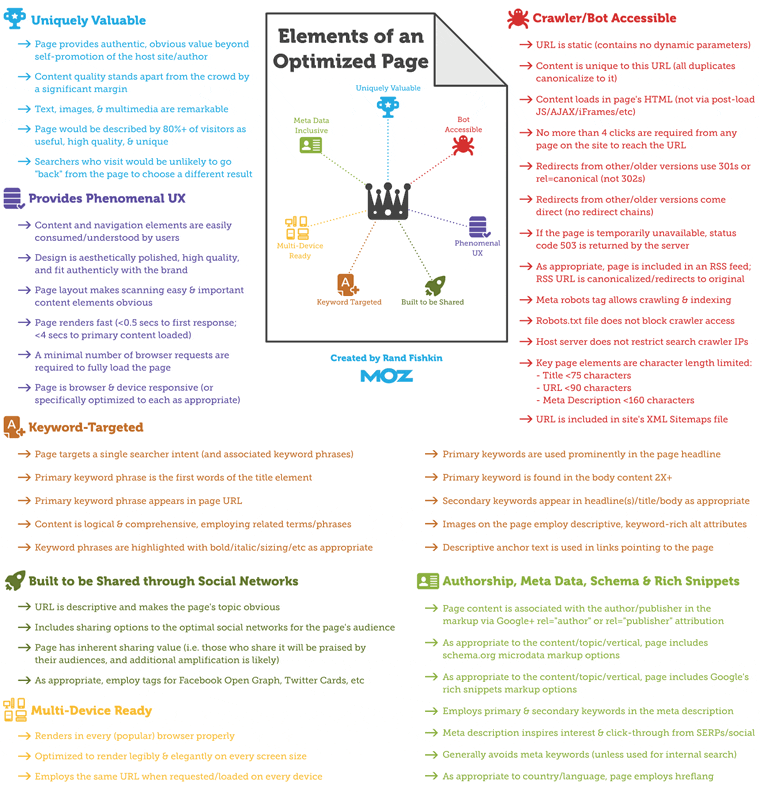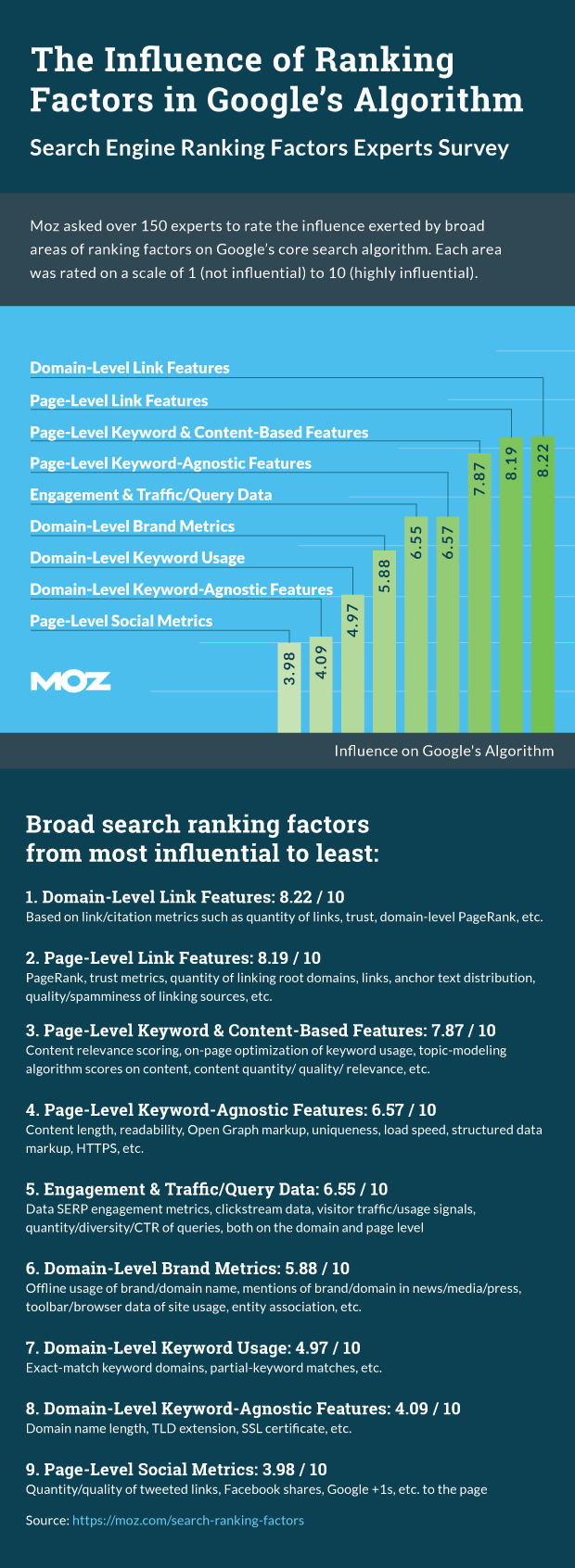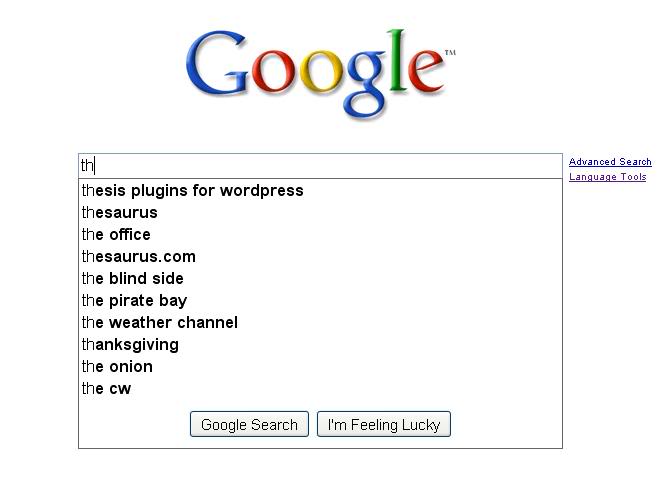Building Optimized Web Pages
 There is no one single SEO factor to guarantee search engine rankings…
There is no one single SEO factor to guarantee search engine rankings…
- Having a great <title> won’t help you if the page has low quality content.
- Having many inbound links won’t help if they are all from low quality sources.
It takes a combination of positive factors working together in harmony that will increase your odds of success, while the presence of negative factors can worsen those odds.
This section is about on-page ranking factors. The type of content you publish, HTML page coding and site architecture are all factors that you control – are you helping or hurting your website?
On-Page Ranking Factors
There are hundreds of “best practices” lists that tell you where to place keywords and how to do “on-page optimization.” In the beginning it was simple – search engines liked to see keywords in certain locations of the HTML code which indicated a web page’s relevance for that keyword.
Today, this approach won’t work for two key reasons:
- The relevancy and keyword-based algorithms that Google and Bing use to evaluate and rank pages are massively more complex (and gaining more sophistication everyday).
- Gaining a slight benefit in a keyword placement-based algorithmic element may harm overall rankings due to negatively impacting your visitors experience. If their experience is bad, then their willingness to stay on your pages, link to you, or share your content socially will be affected.
Search engines have evolved and as other sources of traffic (like social networks, referring links, blogs, etc.) have become more intertwined and important, the very nature of what’s “optimal” is open for debate.
Below is a visualization (created by Rand Fishkin) to explain modern on-page optimization and keyword targeting.

As you can see, it takes more than words on a page. You should strive for:
- Content your audience finds valuable
- That is easy for your audience to navigate (site architecture)
- Optimized for the search phrases your audience use (keyword rich)
- That is easy for your audience to share on social platforms (proper meta data)
- That is viewable on multiple devices like desktops and mobile (responsive and AMP ready)
- That is search engine crawlable (equals indexable)
- That is written in the correct markup for optimal effectiveness
What Do the Experts Think?

Every two years, The Moz Blog surveys the opinion of the world’s brightest search marketers and runs correlation studies to better understand the workings of search engine algorithms. According to the latest survey on “Search Engine Ranking Factors,” 7.87/10 marketers state that Google’s ranking equation is tied to page level keywords and content. This means that you can sacrifice that “perfect” keyword placement for a better user experience, a higher chance of content sharing on social networks, or better click through in the search results.
It’s More About Value & Usefulness
An optimized page doesn’t just provide unique content – it provides unique value. What’s the difference?
Unique content simply means the content does not appear anywhere else on the web.
Unique value, on the other hand, refers to usefulness of a web page and the value its’ visitors receive. Many pages can be “valuable,” but few provide truly unique information that visitors can’t find on other pages targeting that same keyword phrase.
Audience Targeting
Content is king! You’ll hear and read about content when it comes to SEO success – and that’s why we start this section with content quality. Get your content right and you’ve created a solid foundation to build your SEO efforts.

The search process begins with words (keywords) typed into a search query. In fact, the entire science of information retrieval (including web-based search engines like Google) is based on words (called keywords). As the engines crawl and index the contents of millions of pages around the web, they keep track of those pages in keyword-based indexes.
Rather than storing 25 billion web pages all in one gigantic database, the search engines have millions and millions of smaller databases, each centered on a particular keyword term or phrase. This makes it much easier for search engines to retrieve the data they need in fractions of a second.
The Importance of Keywords and Web Page Content
![]() You know that keywords dominate search and influence the interpretation of our web age in the search engine results. When a search is performed, the engine matches web pages to retrieve based on the words entered into the search box. Other data, such as the order of the words (“bows” versus “bows and arrows”), spelling, punctuation, and capitalization of those keywords provide additional information that the engines use to help retrieve the right pages and rank them.
You know that keywords dominate search and influence the interpretation of our web age in the search engine results. When a search is performed, the engine matches web pages to retrieve based on the words entered into the search box. Other data, such as the order of the words (“bows” versus “bows and arrows”), spelling, punctuation, and capitalization of those keywords provide additional information that the engines use to help retrieve the right pages and rank them.
Search engines are able to measure the ways keywords are used on web pages to determine the “relevance” of a particular document to a query. From an SEO perspective, you need to ensure that keywords are prominently used in titles, text, and meta data to optimize your web page. The more specific your keywords, the better your chances of ranking based on less competition.
Quality
The quality of your content is the single most important factor in drawing website visitors…
More than anything else, are you producing quality content? Do you provide a reason for people to spend more than a few seconds reading your pages? Do you offer real value, something of substance to visitors, something unique, different, useful, that they won’t find elsewhere?
These are just some of the questions to ask yourself in assessing whether you’re providing quality content. This is not the place to skimp since it is the cornerstone upon which nearly all other factors depend.
Research
Good keyword research is the second most important SEO factor (right after page content). By discovering the terms that website visitors are using to find information, you’ll be able to create the keyword rich, quality content they are after.
Approach it like answering a question… If someone is querying “how to make balloon animals?” You need to provide the best source of information on making balloon animals on the Internet. If there are special terms within your niche, your content needs to be written in the right “language” – the language your customers are using when searching.
Keyword Use
Once you’ve completed your research and discovered the terms your customers are searching for – have you actually used those terms in your content? Bottom line, if you want to rank for a certain keyword phrase then you need to use that keyword phrase within your content.
How often should you use your keywords in content? It’s more important to create great, relevant, and unique content than to worry about the keyword density on a page. Use common sense and use the keywords naturally.
Visitor Engagement
If you are publishing meaningful content that your visitors want they will “interact” with it in a variety of ways. They will stay on your website and click through your content, they will comment about it, post about it, and share it on social media sites with friends and colleagues. All of these actions are called “engagement” and search engines measure this and use it as one of the factors in determining ranking.
Content Freshness
In addition to content, search engines love freshness. Search engines are trying to return the most relevant and best answer to every search query… Do you think you will find outdated information in the search results? In 2009, Google began implementing their Query Deserves Freshness (QDF) filter to combat outdated content in the query results.
So how do you keep your website fresh? You can’t update your web pages everyday and adding new content “just to add content” doesn’t work either. What you can do? The best suggestion – keep current within your industry.
Example:
Think about it like a ‘hurricane’. If there’s no active hurricane, then the search results will likely contain listings to government and reference sites. But if there’s an active hurricane, results will change and may reflect stories, news and information about the active hurricane.
If you’ve got the right content, on the right topic when QDF hits, you may enjoy being in the top results for days or weeks. Just be aware that after that, your page might be shuffled back in search results. It’s not that you’ve done anything wrong. It’s just that the freshness boost has worn off.
Bonus Reading
![]() Frustrated with conflicting information about keyword density, Dr. Edel Garcia decided to create a “balanced article” mixed with a bit of IR, semantics and math elements to let readers draw their own conclusion regarding the importance of keyword density. You can read about his research in the e-marketing news article, “The Keyword Density of Non-Sense.”
Frustrated with conflicting information about keyword density, Dr. Edel Garcia decided to create a “balanced article” mixed with a bit of IR, semantics and math elements to let readers draw their own conclusion regarding the importance of keyword density. You can read about his research in the e-marketing news article, “The Keyword Density of Non-Sense.”
![]() SEO’s routinely face the challenge of creating pages that will easily rank for their keywords but where do you start? Rand Fishkin wrote: A Visual Guide to Keyword Targeting and On-Page SEO in 2014 and his message is still relevant today.
SEO’s routinely face the challenge of creating pages that will easily rank for their keywords but where do you start? Rand Fishkin wrote: A Visual Guide to Keyword Targeting and On-Page SEO in 2014 and his message is still relevant today.
![]() As you now know, it takes more than just words on a page to rank today. Enticing Page titles, bullet points, strong calls to action and well written content is essential for ranking success. To get you pointed in the right direct, here is a list of the 128 Greatest Copywriters and Resources of the Internet Age. Great copy is great copy – regardless of the platform!
As you now know, it takes more than just words on a page to rank today. Enticing Page titles, bullet points, strong calls to action and well written content is essential for ranking success. To get you pointed in the right direct, here is a list of the 128 Greatest Copywriters and Resources of the Internet Age. Great copy is great copy – regardless of the platform!
![]() While we’re on the subject of page content, I should mention that the ability to write great copy will go a long way with helping you as a marketing professional. From crafting awesome headlines to click generating meta descriptions (and everything in between) – check out this useful collection of resources from Kissmetrics – 75 Resources for Writing Incredible Copy that Converts.
While we’re on the subject of page content, I should mention that the ability to write great copy will go a long way with helping you as a marketing professional. From crafting awesome headlines to click generating meta descriptions (and everything in between) – check out this useful collection of resources from Kissmetrics – 75 Resources for Writing Incredible Copy that Converts.
![]() I’ve already mentioned UX and it’s role in design – now I need to mentioned psychology. Sales copy has long employed emotional triggers to manipulate the reader into taking action and great web design does the same thing. From color section to button shapes (and everything in between), today’s internet is more fueled by science than art. This UX Crash Course will teach you the psychology behind UX design.
I’ve already mentioned UX and it’s role in design – now I need to mentioned psychology. Sales copy has long employed emotional triggers to manipulate the reader into taking action and great web design does the same thing. From color section to button shapes (and everything in between), today’s internet is more fueled by science than art. This UX Crash Course will teach you the psychology behind UX design.